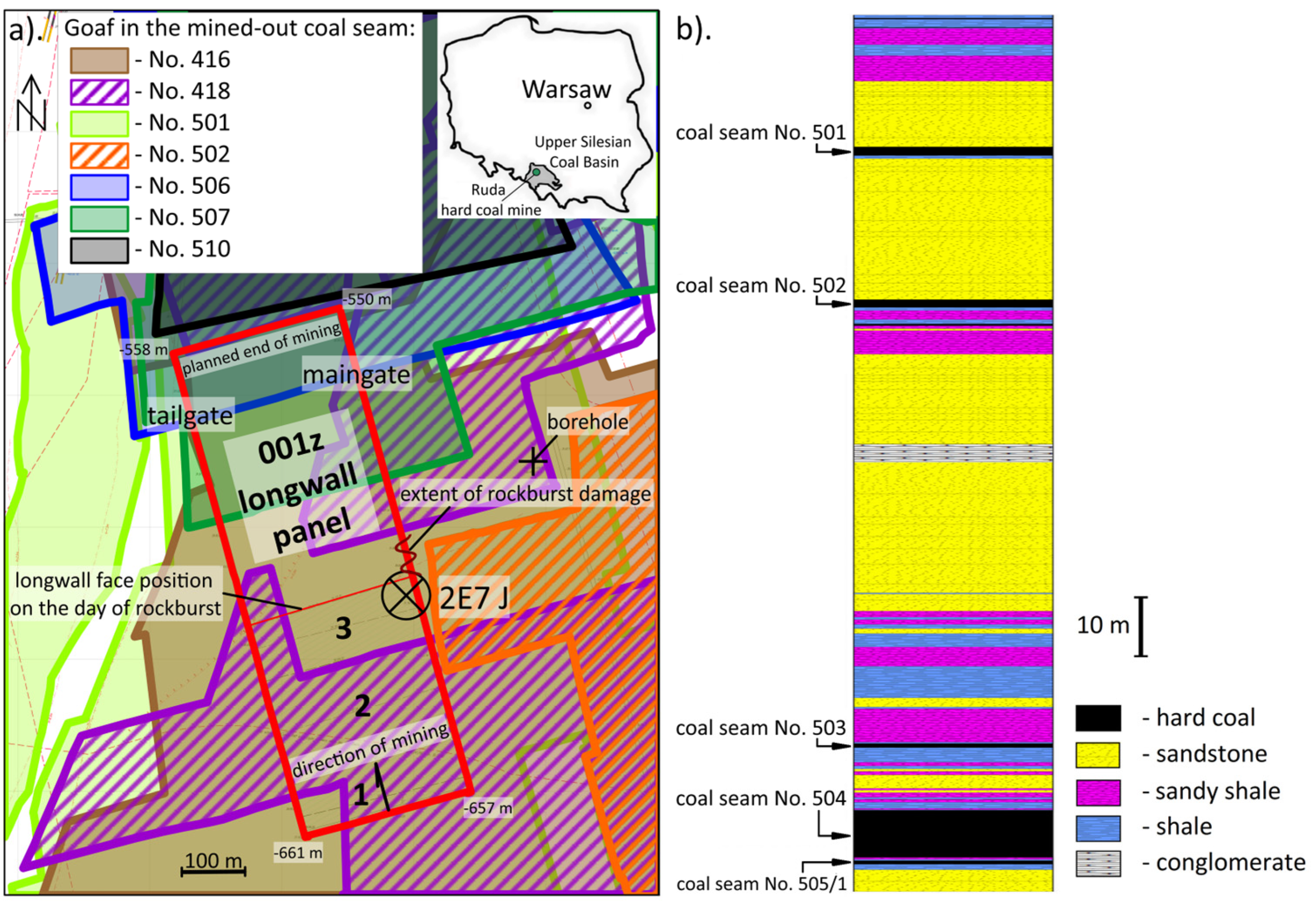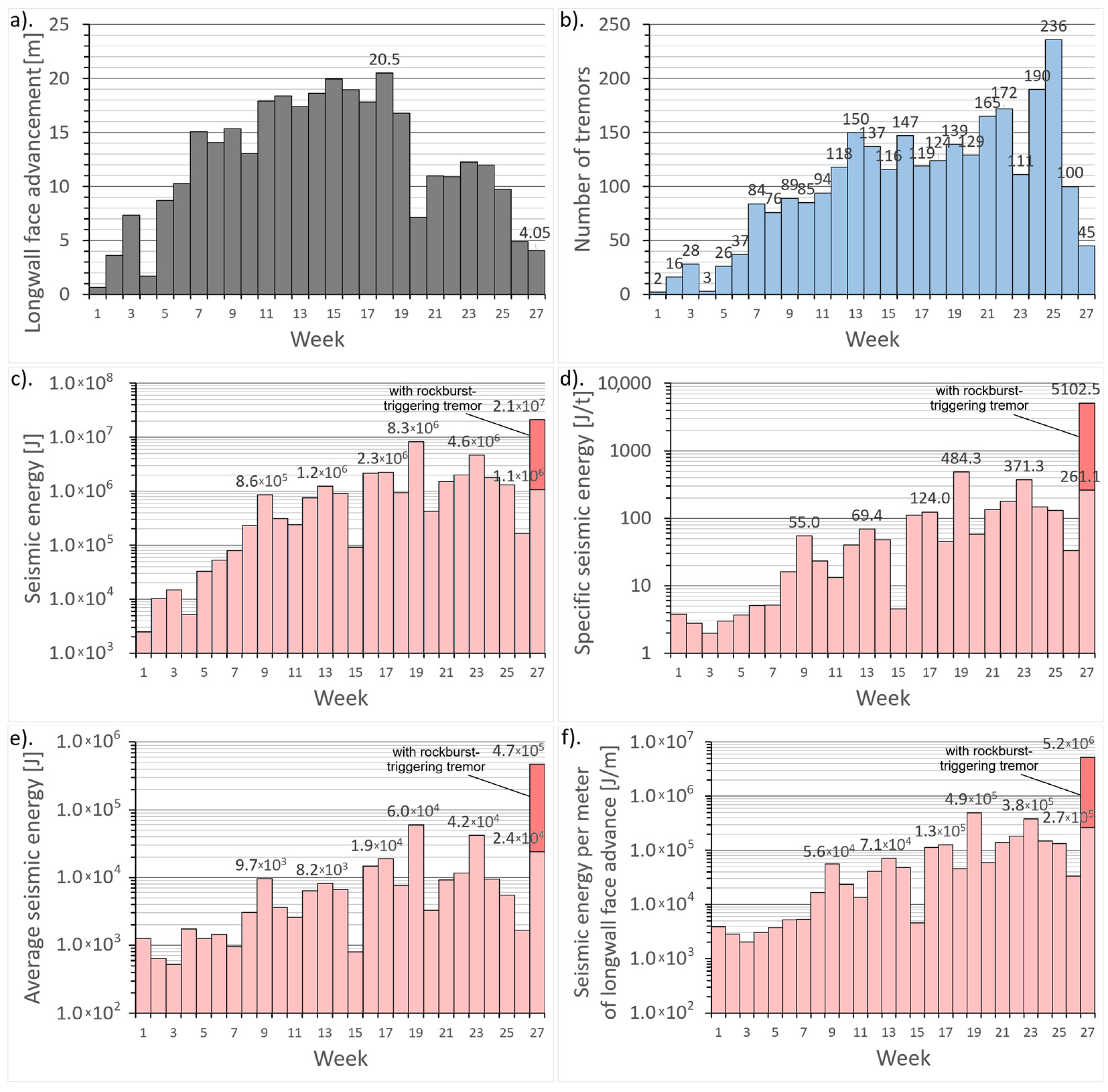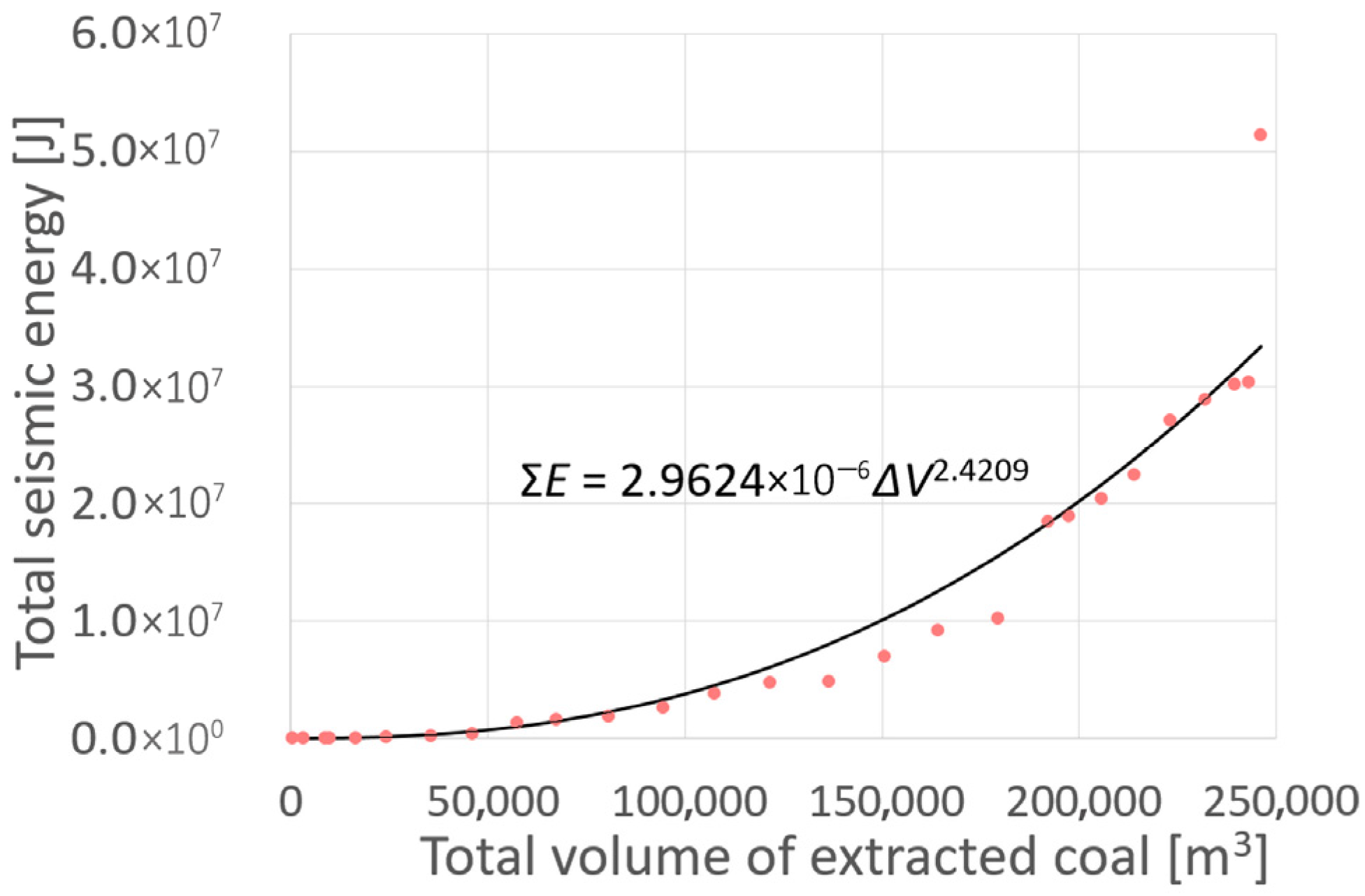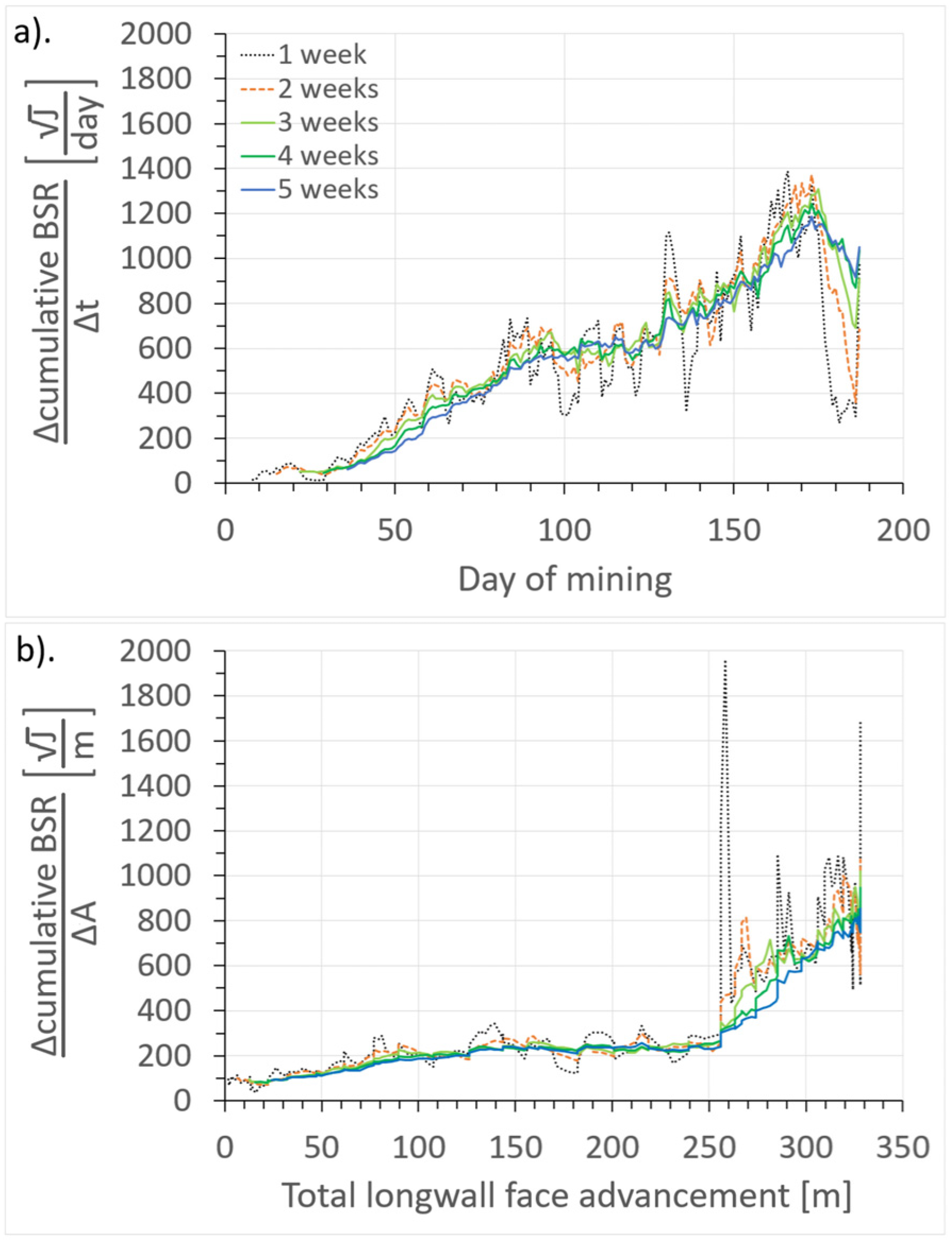Variability and Trends in Selected Seismological Parameters During Longwall Mining of a Coal Seam Disrupted by a Rockburst
Abstract
1. Introduction
2. Materials and Methods
2.1. Geological and Mining Conditions
2.2. Seismic Monitoring During the Extraction of the 001z Longwall Panel
2.3. Seismological Parameters
2.3.1. Number of Tremors, Seismic Energy, and Energy-Related Parameters
2.3.2. Benioff Strain Release
3. Results
3.1. Seismic Activity and Associated Energy Parameters
3.2. Analysis of Benioff Strain Release
4. Discussion
5. Conclusions
- Seismic activity and energy release during the longwall mining of a coal seam are correlated with geological and mining conditions. Caving of the immediate and high roof rocks, previous extraction of adjacent coal seams resulting in edge-induced stress increases and a destress effect, and the rate of ongoing extraction of the longwall panel are reflected in the recorded seismic activity.
- Seismic energy release may demonstrate a clear cyclicity throughout the mining process. This regular pattern provides valuable insight for anticipating dynamic changes and potential rockbursts.
- Mining progress, expressed, for example, by longwall face advancement or volume of extracted coal, is a critical factor in controlling seismic energy emission.
- With reduced longwall panel extraction, seismic activity per unit of longwall face advancement either remained proportional or experienced a slight decline. Over time, however, a clear reduction in activity became evident.
- A clear, accelerating buildup of cumulative BSR over time was observed before a moment of rockburst, although this pattern included a short phase of reduced activity correlated with a reduction in longwall face advancement. In the proposed advancement-to-failure models, the acceleration remains closer to the moment of rockburst, as the seismic activity relative to face advancement does not drop as drastically as in the time-based models. This behavior suggests that the advancement-based approach may more precisely capture the changes in the system’s stress state preceding critical events in hard coal mines. Moreover, advancement-to-failure models exhibited the highest KA values in the immediate vicinity of the main tremor focus (R ≤ 100 m), indicating a stronger local effect. The lowest mA value in this near-focus region suggests a rapid and localized strain concentration. The most critical dynamics of strain accumulation occurred in close proximity to the main tremor focus.
- A sudden reduction in longwall face advancement interrupted the typical continuous buildup of strain. In the cumulative BSR failure models, the expected precursory acceleration was absent—or even reversed. During this period, the time-to-failure and advancement-to-failure models demonstrated slightly negative m values in the immediate vicinity of the main tremor focus, i.e., within radii of R ≤ 100 m and R ≤ 200 m, respectively. The advancement-to-failure model effectively describes strain accumulation linked to mining progress and provides valuable insights into mechanical system responses. Similarly, the time-to-failure model captures the temporal evolution of strain release and seismicity, but under stable longwall face advancement. However, the accuracy of both models is limited during significant reductions in longwall face advancement, with the time-to-failure model tending to exhibit greater deviations under these conditions. This leads to regression artifacts such as negative m values and deviations from the expected acceleration pattern due to complex stress redistribution.
- The cumulative BSR trends exhibited a marked decline over time preceding the rockburst, which appears to be due to a decrease in seismic activity resulting from reduced longwall face advancement rather than from a phase of typical quiescence. Conversely, when examining cumulative BSR relative to longwall face advancement, the trend was more sustained—particularly for wider windows—suggesting that the spatial evolution of strain release is less disrupted by the decline in extraction.
Author Contributions
Funding
Institutional Review Board Statement
Informed Consent Statement
Data Availability Statement
Acknowledgments
Conflicts of Interest
References
- Bollinger, G.A. Microearthquake Activity Associated with Underground Coal Mining in Buchanan County, Virginia, U.S.A. Pure Appl. Geophys. 1989, 129, 407–413. [Google Scholar] [CrossRef]
- Swanson, P.; Boltz, M.S.; Chambers, D. Seismic Monitoring Strategies for Deep Longwall Coal Mines; National Institute for Occupational Safety and Health (NIOSH) Publication No. 2017-102, RI 9700, October 2016; NIOSH: Cincinnati, OH, USA, 2016. [Google Scholar]
- Ghosh, G.K.; Sivakumar, C. Application of Underground Microseismic Monitoring for Ground Failure and Secure Longwall Coal Mining Operation: A Case Study in an Indian Mine. J. Appl. Geophys. 2018, 150, 21–39. [Google Scholar] [CrossRef]
- Verdon, J.P.; Kendall, J.-M.; Butcher, A.; Luckett, R.; Baptie, B.J. Seismicity Induced by Longwall Coal Mining at the Thoresby Colliery, Nottinghamshire, U.K. Geophys. J. Int. 2018, 212, 942–954. [Google Scholar] [CrossRef]
- Cao, J.; Dou, L.; Zhang, X.; Gong, S.; Han, Y.; Li, G.; Liu, C.; Chen, Y. Study on the Mechanism of Mining-Induced Seismicity Triggered by Fracture of Hard and Extremely Thick Rock Stratum: A Case Study. Front. Earth Sci. 2025, 13, 1556612. [Google Scholar] [CrossRef]
- Marcak, H.; Mutke, G. Seismic Activation of Tectonic Stresses by Mining. J. Seismol. 2013, 17, 1139–1148. [Google Scholar] [CrossRef]
- Konicek, P.; Kajzar, V.; Schreiber, J. Seismic Activity of Hard Coal Longwall Mining in Protective Shaft Pillar near Closed Room and Pillar Panel. IOP Conf. Ser. Earth Environ. Sci. 2021, 833, 012087. [Google Scholar] [CrossRef]
- Lurka, A. Spatio-Temporal Hierarchical Cluster Analysis of Mining-Induced Seismicity in Coal Mines Using Ward’s Minimum Variance Method. J. Appl. Geophys. 2021, 184, 104249. [Google Scholar] [CrossRef]
- Jarufe, J. Using Seismic Hazard to Improve Underground Mine Planning. In Deep Mining 2024: Proceedings of the 10th International Conference on Deep and High Stress Mining; Andrieux, P., Cumming-Potvin, D., Eds.; Australian Centre for Geomechanics: Perth, Australia, 2024; pp. 1309–1318. [Google Scholar]
- Li, M.; Kurata, M. Probabilistic Updating of Fishbone Model for Assessing Seismic Damage to Beam-Column Connections in Steel Moment-Resisting Frames. Comput. Aided Civ. Inf. Eng. 2019, 34, 790–805. [Google Scholar] [CrossRef]
- Zhang, X.; Guo, D.; Dias, D.; Sun, Z. Dynamic Probabilistic Analysis of Non-Homogeneous Slopes Based on a Simplified Deterministic Model. Soil Dyn. Earthq. Eng. 2021, 142, 106563. [Google Scholar] [CrossRef]
- Cook, N. Seismicity Associated with Mining. Eng. Geol. 1976, 10, 99–122. [Google Scholar] [CrossRef]
- Brady, B.T. Anomalous Seismicity Prior to Rock Bursts: Implications for Earthquake Prediction. Pure Appl. Geophys. 1977, 115, 357–374. [Google Scholar] [CrossRef]
- Gibowicz, S.J. Space and Time Variations of the Frequency-Magnitude Relation for Mining Tremors in the Szombierki Coal Mine in Upper Silesia, Poland. Acta Geophys. Pol. 1979, 27, 39–49. [Google Scholar]
- Sato, K.; Fujii, Y. Induced Seismicity Associated with Longwall Coal Mining. Int. J. Rock Mech. Min. Sci. Geomech. Abstr. 1988, 25, 253–262. [Google Scholar] [CrossRef]
- Gibowicz, S.J. Seismicity Induced by Mining. Adv. Geophys. 1990, 32, 1–74. [Google Scholar]
- Young, R.P.; Maxwell, S.C.; Urbancic, T.I.; Feignier, B. Mining-Induced Microseismicity: Monitoring and Applications of Imaging and Source Mechanism Techniques. Pure Appl. Geophys. 1992, 139, 697–719. [Google Scholar] [CrossRef]
- Eneva, M.; Young, R.P. Evaluation of Spatial Patterns in the Distribution of Seismic Activity in Mines: A Case Study of Creighton Mine, Northern Ontario (Canada). In Rockbursts and Seismicity in Mines; Balkema: Lisse, The Netherlands, 1993; pp. 175–180. [Google Scholar]
- Kijko, A.; Funk, C.W.; Brink, A.V.Z. Identification of Anomalous Patterns in Time-Dependent Mine Seismicity. In Rockbursts and Seismicity in Mines; Balkema: Lisse, The Netherlands, 1993; pp. 205–210. [Google Scholar]
- Gibowicz, S.J.; Kijko, A. An Introduction to Mining Seismology; Academic Press: San Diego, CA, USA, 1994. [Google Scholar]
- Lasocki, S. Precursor of Strong Tremors? Dispersion of Foci–A Possible Precursor of Strong Tremors? Acta Mont. 1996, 100, 83–89. [Google Scholar]
- Srinivasan, C.; Arora, S.K.; Yaji, R.K. Use of Mining and Seismological Parameters as Pre-monitors of Rockbursts. Int. J. Rock Mech. Min. Sci. 1997, 34, 1001–1008. [Google Scholar] [CrossRef]
- Eneva, M. In Search for a Relationship between Induced Microseismicity and Larger Events in Mines. Tectonophysics 1998, 289, 91–104. [Google Scholar] [CrossRef]
- Mendecki, A.J. A Guide to Routine Seismic Monitoring in Mines; Creda Communications: Cape Town, South Africa, 1999. [Google Scholar]
- Gibowicz, S.J.; Lasocki, S. Seismicity Induced by Mining: Ten Years Later. Adv. Geophys. 2001, 44, 39–181. [Google Scholar]
- Bischoff, M.; Cete, A.; Fritschen, R.; Meier, T. Coal Mining Induced Seismicity in the Ruhr Area, Germany. Pure Appl. Geophys. 2010, 167, 63–75. [Google Scholar] [CrossRef]
- Mendecki, A.J. Characteristics of Seismic Hazard in Mines: Keynote Lecture. In Characteristics of Seismic Hazard in Mines; Mendecki, A.J., Ed.; Academia.edu: San Francisco, CA, USA, 2012; pp. 1–23. [Google Scholar]
- Lu, C.-P.; Dou, L.-M.; Zhang, N.; Xue, J.-H.; Wang, X.-N.; Liu, H.; Zhang, J.-W. Microseismic Frequency-Spectrum Evolutionary Rule of Rockburst Triggered by Roof Fall. Int. J. Rock Mech. Min. Sci. 2013, 64, 6–16. [Google Scholar] [CrossRef]
- Mutke, G.; Dubiński, J.; Lurka, A. New Criteria to Assess Seismic and Rock Burst Hazard in Coal Mines. Arch. Min. Sci. 2015, 60, 743–760. [Google Scholar] [CrossRef]
- Konicek, P.; Waclawik, P. Stress Changes and Seismicity Monitoring of Hard Coal Longwall Mining in High Rockburst Risk Areas. Tunn. Undergr. Space Technol. 2018, 81, 237–251. [Google Scholar] [CrossRef]
- Dong, L.; Sun, D.; Shu, W.; Li, X.; Zhang, L. Statistical Precursor of Induced Seismicity Using Temporal and Spatial Characteristics of Seismic Sequence in Mines. In Advances in Acoustic Emission Technology; WCAE 2017; Springer Proceedings in Physics; Shen, G., Zhang, J., Wu, Z., Eds.; Springer: Cham, Switzerland, 2019; Volume 218. [Google Scholar] [CrossRef]
- Mendecki, M.J.; Wojtecki, Ł.; Zuberek, W.M. Case Studies of Seismic Energy Release and Benioff Strain in Underground Coal Mines. Pure Appl. Geophys. 2019, 176, 2479–2500. [Google Scholar] [CrossRef]
- Rudziński, Ł.; Mirek, K.; Mirek, J. Rapid Ground Deformation Corresponding to a Mining-Induced Seismic Event Followed by a Massive Collapse. Nat. Hazards 2019, 96, 461–471. [Google Scholar] [CrossRef]
- Nordström, E.; Dineva, S.; Nordlund, E. Back Analysis of Short-Term Seismic Hazard Indicators of Larger Seismic Events in Deep Underground Mines (LKAB, Kiirunavaara Mine, Sweden). Pure Appl. Geophys. 2020, 177, 763–785. [Google Scholar] [CrossRef]
- Ma, T.-h.; Tang, C.-a.; Liu, F.; Zhang, S.-c.; Feng, Z. Microseismic Monitoring, Analysis and Early Warning of Rockburst. Geomat. Nat. Hazards Risk 2021, 12, 2956–2983. [Google Scholar] [CrossRef]
- Mendecki, M.J.; Pakosz, R.; Wojtecki, Ł.; Zuberek, W.M. Spatiotemporal Analysis of Elastic and Inelastic Deformations in Roof Rocks from Seismological Observations. Int. J. Min. Sci. Technol. 2021, 31, 389–402. [Google Scholar] [CrossRef]
- Zhang, C.; Jin, G.; Liu, C.; Li, S.; Xue, J.; Cheng, R.; Wang, X.; Zeng, X. Prediction of Rock-Bursts in a Typical Island Working Face of a Coal Mine through Microseismic Monitoring Technology. Tunn. Undergr. Space Technol. 2021, 113, 103972. [Google Scholar] [CrossRef]
- Yang, Y.; Cao, A.; Liu, Y.; Bai, X.; Yan, Z.; Wang, S.; Wang, C. Understanding the Mechanism of Strong Mining Tremors near the Goaf Area of Longwall Mining: A Case Study. Appl. Sci. 2023, 13, 5364. [Google Scholar] [CrossRef]
- Goulet, A.; Grenon, M.; Hadjigeorgiou, J. Understanding Seismic Hazards Associated with Development Mining: The Role of Local Geology and Structures. Geotech. Geol. Eng. 2024, 42, 3137–3169. [Google Scholar] [CrossRef]
- Sun, W.; Wang, E.; Li, J.; Liu, Z.; Zhang, Y.; Qiu, J. Mining-Induced Earthquake Risk Assessment and Control Strategy Based on Microseismic and Stress Monitoring: A Case Study of Chengyang Coal Mine. Appl. Sci. 2024, 14, 11951. [Google Scholar] [CrossRef]
- Xue, Y.; Li, Z.; Song, D.; He, X.; Wang, H.; Zhou, C.; Chen, J.; Sobolev, A. A Method to Predict Rockburst Using Temporal Trend Test and Its Application. J. Rock Mech. Geotech. Eng. 2024, 16, 909–923. [Google Scholar] [CrossRef]
- Lin, H.; Zhang, Q.; Duan, K.; Wang, P.; Zhang, X.; Liu, C.; Chen, C.; Zhao, Y. Geo-mechanical Model Test on Strong Mine Tremors Induced by the Breakage of High Thick-and-Hard Overlying Strata During Longwall Coal Retreat Mining. Rock Mech. Rock Eng. 2025, 58, 5549–5578. [Google Scholar] [CrossRef]
- Mao, H.; Xu, N.; Li, X.; Li, B.; Xiao, P.; Li, Y.; Li, P. Analysis of Rockburst Mechanism and Warning Based on Microseismic Moment Tensors and Dynamic Bayesian Networks. J. Rock Mech. Geotech. Eng. 2023, 15, 2521–2538. [Google Scholar] [CrossRef]
- Lurka, A. Combining Deep Neural Network and Spatio-temporal Clustering to Automatically Assess Rockburst and Seismic Hazard–Case Study from Marcel Coal Mine in Upper Silesian Basin, Poland. Comput. Geosci. 2024, 192, 105709. [Google Scholar] [CrossRef]
- Li, X.; Si, G.; Cao, W.; Cai, W.; Oh, J.; Ismet, C. A Sequence of Seismic Event Triggering in Longwall Coal Mines Based on the Aftershock Cascade Theory. Int. J. Rock Mech. Min. Sci. 2024, 182, 105883. [Google Scholar] [CrossRef]
- Dubiński, J.; Wierzchowska, Z. Methods for Calculating the Seismic Energy of Tremors in Upper Silesia. Sci. Work. Cent. Min. Inst. 1973, 591, 3–23. (In Polish) [Google Scholar]
- Stec, K.; Lurka, A. Characteristics and Seismologic Methods of Analysis of Seismic Activity in the Upper Silesian Coal Basin. Pol. Min. Rev. 2015, 1, 83–93. (In Polish) [Google Scholar]
- Gerlach, Z. Prediction of Seismic Hazard in Mining Conditions. In Geophysical Investigations in Mines; Dubiński, J., Pilecki, Z., Zuberek, W.M., Eds.; IGSMiE PAN: Cracow, Poland, 2001. (In Polish) [Google Scholar]
- Benioff, H. Energy Release in Earthquakes. Bull. Seismol. Soc. Am. 1951, 41, 1676–1687. [Google Scholar]
- Bath, M.; Benioff, H. The Aftershock Sequence of the Kamchatka Earthquake of November 4, 1952. Bull. Geol. Soc. Am. 1958, 48, 1–15. [Google Scholar] [CrossRef]
- Chouhan, R.K.S. Regional Strain Release Characteristics for Indian Regions. Bull. Geol. Soc. Am. 1966, 56, 749–754. [Google Scholar] [CrossRef]
- Das, S.; Scholz, C.H. Theory of Time-Dependent Rupture in the Earth. J. Geophys. Res. Solid Earth 1981, 86, 6039–6051. [Google Scholar] [CrossRef]
- Kawada, Y.; Nagahama, H. Cumulative Benioff Strain Release, Modified Omori’s Law and Transient Behaviour of Rocks. Tectonophysics 2006, 424, 157–166. [Google Scholar] [CrossRef]
- Jiang, C.; Wu, Z. Test of the Preshock Accelerating Moment Release (AMR) in the Case of the 26 December 2004 Mw 9.0 Indonesia Earthquake. Bull. Seismol. Soc. Am. 2005, 95, 2016–2025. [Google Scholar] [CrossRef]
- Jiang, C.; Wu, Z. Benioff Strain Release Before Earthquakes in China: Accelerating or Not? Pure Appl. Geophys. 2006, 163, 1965–1976. [Google Scholar] [CrossRef]
- Voight, B. A Relation to Describe Rate-Dependent Material Failure. Science 1989, 243, 200–203. [Google Scholar] [CrossRef]
- Varnes, D.J. Predicting Earthquakes by Analyzing Accelerating Precursory Seismic Activity. Pure Appl. Geophys. 1989, 130, 661–686. [Google Scholar] [CrossRef]
- Jaumé, S.C.; Sykes, L.R. Evolving Towards a Critical Point: A Review of Accelerating Seismic Moment/Energy Release Prior to Large and Great Earthquakes. Pure Appl. Geophys. 1999, 155, 279–305. [Google Scholar] [CrossRef]
- Brehm, D.J.; Braile, L.W. Intermediate-Term Earthquake Prediction Using Precursory Events in the New Madrid Seismic Zone. Bull. Seismol. Soc. Am. 1998, 88, 564–580. [Google Scholar] [CrossRef]
- Brehm, D.J.; Braile, L.W. Intermediate-Term Earthquake Prediction Using the Modified Time-to-Failure Method in Southern California. Bull. Seismol. Soc. Am. 1999, 89, 275–293. [Google Scholar] [CrossRef]
- Bowman, D.D.; Ouillon, G.; Sammis, C.G.; Sornette, A.; Sornette, D. An Observational Test of the Critical Earthquake Concept. J. Geophys. Res. Solid Earth 1998, 103, 24359–24372. [Google Scholar] [CrossRef]







| Radius | Number of Tremors | Kt | kt | nt | mt |
|---|---|---|---|---|---|
| R ≤ 100 m | 531 | 384,219.2 | 14,052.3 | 1.04 | 0.04 |
| R ≤ 200 m | 1393 | 563,470.9 | 23,844.9 | 1.05 | 0.05 |
| R ≤ 300 m | 1996 | 220,420.4 | 16,339.0 | 1.23 | 0.23 |
| R ≤ 400 m | 2293 | 171,535.7 | 9904.1 | 1.38 | 0.38 |
| All tremors | 2398 | 169,481.8 | 9100.8 | 1.40 | 0.40 |
| Radius | Number of Tremors | KA | kA | nA | mA |
|---|---|---|---|---|---|
| R ≤ 100 m | 531 | 520,632.0 | 10,388.5 | 1.02 | 0.02 |
| R ≤ 200 m | 1393 | 489,355.0 | 16,660.7 | 1.04 | 0.04 |
| R ≤ 300 m | 1996 | 181,889.7 | 11,720.5 | 1.20 | 0.20 |
| R ≤ 400 m | 2293 | 160,687.5 | 8931.5 | 1.28 | 0.28 |
| All tremors | 2398 | 156,326.7 | 8033.9 | 1.31 | 0.31 |
| Radius | Number of Tremors | Kt | kt | nt | mt |
|---|---|---|---|---|---|
| R ≤ 100 m | 52 | 15,682.1 | 572.9 | 0.95 | −0.05 |
| R ≤ 200 m | 93 | 63,320.4 | 136.6 | 2.39 | 1.39 |
| R ≤ 300 m | 125 | 91,654.4 | 206.7 | 2.30 | 1.30 |
| R ≤ 400 m | 137 | 104,255.3 | 259.1 | 2.20 | 1.20 |
| All tremors | 140 | 108,223.3 | 262.8 | 2.21 | 1.21 |
| Radius | Number of Tremors | KA | kA | nA | mA |
|---|---|---|---|---|---|
| R ≤ 100 m | 52 | 17,233.5 | 704.2 | 0.93 | −0.07 |
| R ≤ 200 m | 93 | 39,268.5 | 1818.8 | 0.93 | −0.07 |
| R ≤ 300 m | 125 | 91,698.7 | 566.5 | 2.02 | 1.02 |
| R ≤ 400 m | 137 | 104,253.0 | 623.1 | 1.98 | 0.98 |
| All tremors | 140 | 108,229.1 | 637.5 | 1.98 | 0.98 |
Disclaimer/Publisher’s Note: The statements, opinions and data contained in all publications are solely those of the individual author(s) and contributor(s) and not of MDPI and/or the editor(s). MDPI and/or the editor(s) disclaim responsibility for any injury to people or property resulting from any ideas, methods, instructions or products referred to in the content. |
© 2025 by the authors. Licensee MDPI, Basel, Switzerland. This article is an open access article distributed under the terms and conditions of the Creative Commons Attribution (CC BY) license (https://creativecommons.org/licenses/by/4.0/).
Share and Cite
Wojtecki, Ł.; Pakosz, R.; Apel, D.B.; Mendecki, M.J. Variability and Trends in Selected Seismological Parameters During Longwall Mining of a Coal Seam Disrupted by a Rockburst. Appl. Sci. 2025, 15, 8897. https://doi.org/10.3390/app15168897
Wojtecki Ł, Pakosz R, Apel DB, Mendecki MJ. Variability and Trends in Selected Seismological Parameters During Longwall Mining of a Coal Seam Disrupted by a Rockburst. Applied Sciences. 2025; 15(16):8897. https://doi.org/10.3390/app15168897
Chicago/Turabian StyleWojtecki, Łukasz, Rafał Pakosz, Derek B. Apel, and Maciej J. Mendecki. 2025. "Variability and Trends in Selected Seismological Parameters During Longwall Mining of a Coal Seam Disrupted by a Rockburst" Applied Sciences 15, no. 16: 8897. https://doi.org/10.3390/app15168897
APA StyleWojtecki, Ł., Pakosz, R., Apel, D. B., & Mendecki, M. J. (2025). Variability and Trends in Selected Seismological Parameters During Longwall Mining of a Coal Seam Disrupted by a Rockburst. Applied Sciences, 15(16), 8897. https://doi.org/10.3390/app15168897






